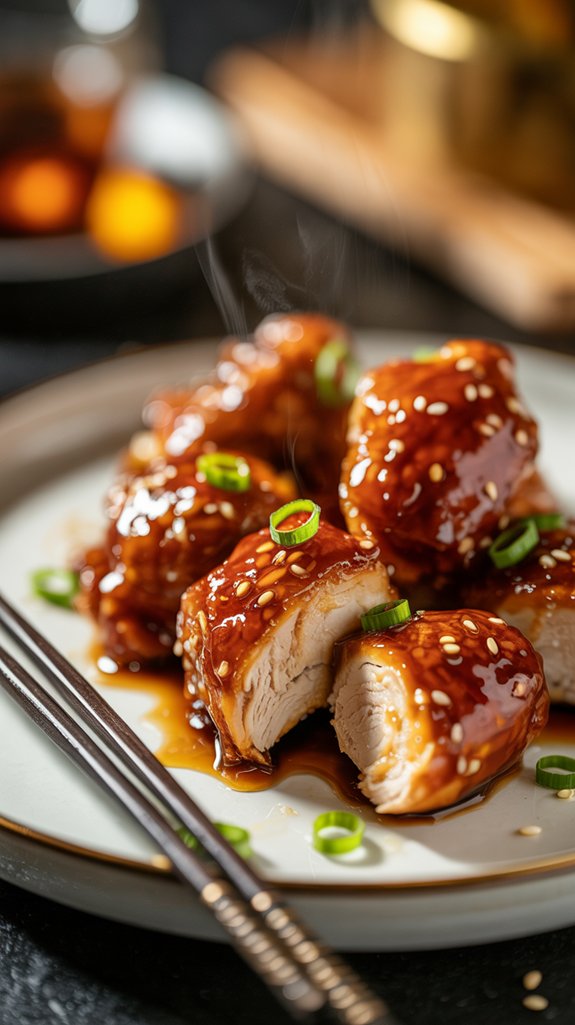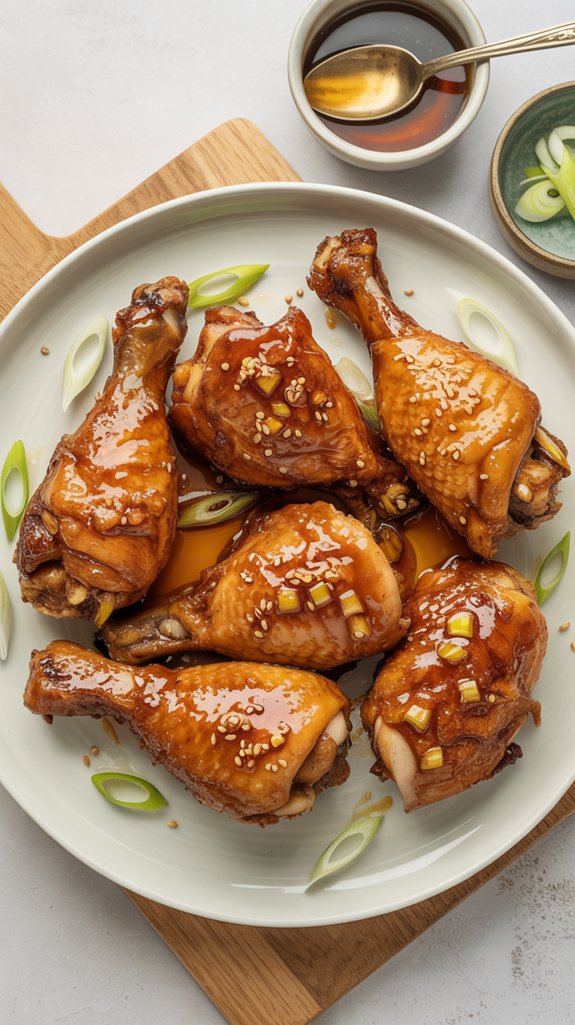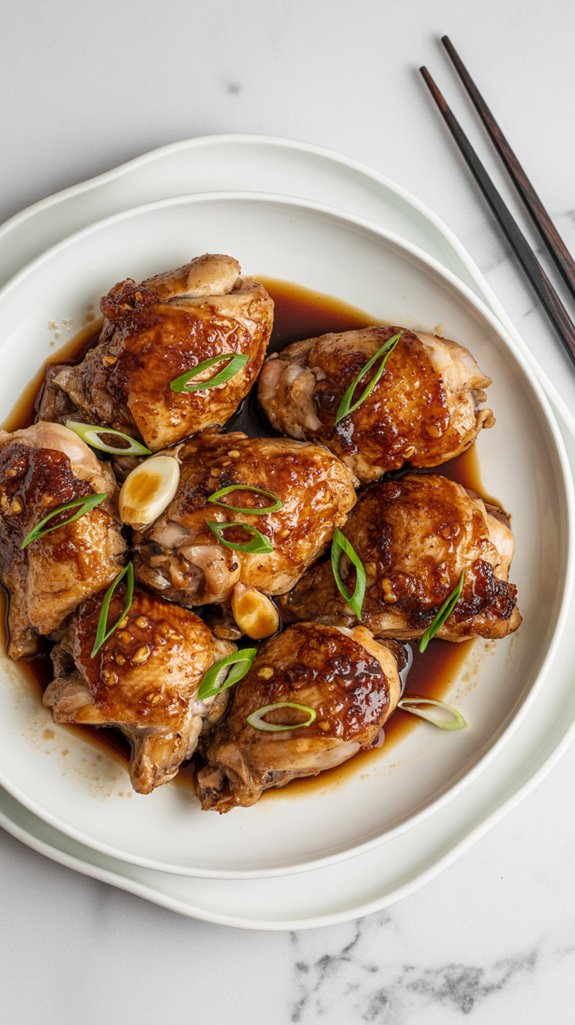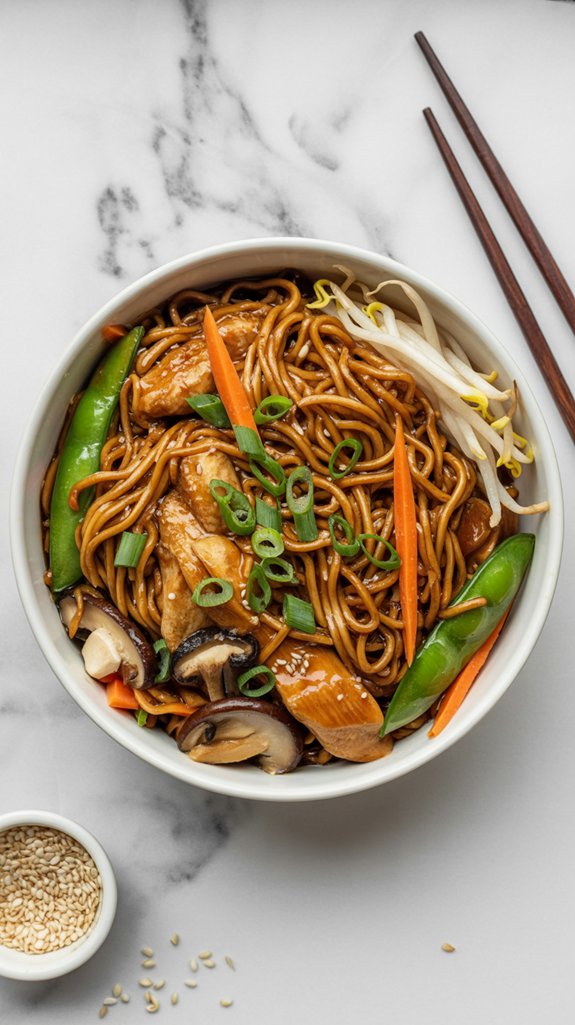Why You’ll Love This this Sweet & Sticky Asian Honey Chicken
This honey chicken recipe is basically a one-bowl wonder that turns ordinary chicken breasts into something that tastes like it came from your favorite takeout spot.
You literally just dump everything into a bag, let it marinate while you binge-watch whatever’s on Netflix, then toss it in the oven for thirty minutes.
The sweet honey and salty soy sauce create this incredible sticky glaze that coats every piece of chicken and veggie, making it impossible to stop eating once you start.
Ingredients List
You’ll need just eight simple ingredients to make this sticky, sweet honey chicken that’ll have everyone asking for seconds.
- 1/4 cup canola oil
- 1/3 cup honey
- 1/3 cup soy sauce
- 1/4 teaspoon pepper
- 4 skinless chicken breasts, cut into cubes
- 2 garlic cloves, whole
- 1 onion, cut into large chunks
- 1 red bell pepper, sliced
- Swap the canola oil for avocado oil if you want a healthier fat that can handle higher cooking temperatures
- Choose low-sodium soy sauce to cut back on the salt content, especially since honey chicken can get pretty salty pretty fast
- Go for organic honey when possible – it’s not just trendy Instagram nonsense, it actually has more antioxidants than the regular stuff
- Load up on extra bell peppers and onions to bulk up the veggie content and make this feel less like a sugar bomb and more like an actual meal
- Make the marinade – Whisk together canola oil, honey, soy sauce, and pepper in a small bowl until well combined.
- Prep the chicken and vegetables – Cut chicken breasts into bite-sized cubes, leave garlic cloves whole, chop onion into large chunks, and slice the red bell pepper.
- Marinate everything – Place chicken, garlic, onion, and red pepper in a large Ziploc bag, pour in the marinade, seal tightly, and refrigerate for at least 2 hours (longer is better).
- Prepare for baking – Drain the marinade from the bag and transfer the chicken and vegetables to a baking dish, spreading them out in a single layer.
- Bake until done – Cook at 350°F for 30 minutes or until the chicken is fully cooked through and no longer pink in the center.
- Rice is your friend – Whether it’s plain white rice, jasmine, or even leftover takeout rice from yesterday, it soaks up that sweet-salty sauce like a dream and makes everything feel more substantial.
- Quick-steamed vegetables – Broccoli, snap peas, or green beans work perfectly, and honestly, you can just toss them in the microwave with a splash of water while the chicken finishes baking.
- Simple noodles – Lo mein noodles, rice noodles, or even regular spaghetti if that’s what’s hiding in your pantry, because let’s be real, carbs make everything better.
- Fresh cucumber salad – Just slice some cucumbers thin, toss with rice vinegar and a pinch of sugar, and you’ve got something cool and crisp to balance all that sticky sweetness.
- Egg rolls or pot stickers – If you’re feeling fancy or have some frozen ones lurking in the freezer, they turn this into a proper feast without much extra work.
- Don’t skip the marinating time – I know two hours feels like forever when you’re hungry, but that’s when the magic happens, and honestly, overnight is even better if you can plan ahead.
- Save some marinade before adding the raw chicken – Set aside a few tablespoons in a separate bowl before it touches the meat, then you can drizzle it over the finished dish without any food safety drama.
- Cut your chicken pieces roughly the same size – Nobody wants some pieces turning into hockey pucks while others are still pink in the middle, and uniform chunks cook way more evenly.
- Toss everything halfway through baking – Just give the pan a quick shake or stir around the 15-minute mark so nothing gets stuck or burns on the bottom.
- Check for doneness with a thermometer – Chicken should hit 165°F, but if you don’t have one handy, just cut into the biggest piece and make sure there’s no pink hiding in there.
- Let it rest for a few minutes – The sauce will thicken up slightly as it cools, and you won’t burn your tongue trying to taste-test right out of the oven.
- Calories: Approximately 285 per serving
- Protein: 26g from the lean chicken breast
- Carbohydrates: 18g, primarily from honey and vegetables
- Fat: 14g, mostly from heart-healthy canola oil
- Sodium: 800mg from soy sauce (about 33% daily value)
- Sugar: 16g, naturally occurring from honey
- Fiber: 2g from bell pepper and onion
- Vitamin C: 95mg from red bell pepper (over 100% daily value)
- Iron: 1.2mg supporting healthy blood function
- Potassium: 380mg for heart and muscle health
- Cholesterol: 65mg from chicken breast
- Saturated Fat: 2g (10% daily value)
Step by Step Directions

This Asian honey chicken comes together in just a few simple steps that transform basic ingredients into a restaurant-quality dish.
For an even richer flavor and superior heat retention, consider using a dutch oven casserole dish instead of a regular baking dish.
Substitutions and Variations
• Make it more filling – Toss in some pineapple chunks during the last 15 minutes of baking for that classic sweet-and-savory combo that somehow always works, even when it shouldn’t.
Additional Things to Serve With This Dish
This honey chicken practically begs for some good sidekicks to round out the meal.
Cooking Tips & Tricks (Chef’s Notes)
A few little tricks can turn this already simple recipe into something that’ll have people asking for your secret.
Nutritional Facts
This honey chicken recipe serves 4 and delivers a balanced mix of protein, carbs, and essential nutrients in each serving.
Fun “Did You Know?”
While honey chicken might seem like a modern fusion creation, honey has been used to glaze and preserve meats for over 4,000 years across ancient civilizations in China, Egypt, and Greece.
I find it fascinating that honey’s natural enzymes actually tenderize chicken while you’re marinating it.
Here’s something cool: the Maillard reaction between honey’s sugars and the chicken’s proteins creates those gorgeous caramelized edges we all love.
Ancient Chinese cooks identified that honey’s antimicrobial properties helped preserve cooked meats longer.
Today’s soy sauce addition is relatively recent, dating back only to the 17th century in Chinese cooking traditions.





